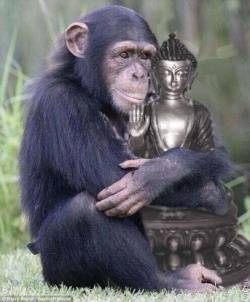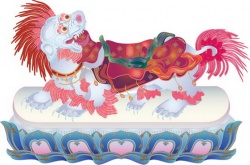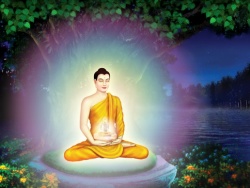Difference between revisions of "Ganachakra (Tsok) Offering"
| Line 25: | Line 25: | ||
'''TO DRINK: | '''TO DRINK: | ||
| − | + | * Wine – white and red | |
* Soft drinks – juices, coke etc | * Soft drinks – juices, coke etc | ||
Revision as of 19:23, 13 March 2019
The practice of Ganachakra Offering (Tsok in Tibetan) is a supreme and profound act of generosity, the perfection of giving. It is also an opportunity to exercise the Paramita of Harmonius Conduct, the perfection of morality.
In the Paramita of Generosity we offer a Mandala of excellent substances which represents the entire universe, It has to be great because we are offering it to the Guru, with the implicit understanding that this means the external, internal and secret Guru.
In the Paramita of Harmonious Conduct we exercise the discipline of organizing the offering, the place of the offering and, most importantly, our own behaviour during this ritual.
The Ganachakra has a profound meaning – it should be approached with the correct view, it is not a party – and the substances we consume are not to satiate our hunger but to remind us of the union of Wisdom and Loving Kindness[1].
The merit of this offering is immense. His Holiness Gyalwang Drukpa has explained that on a first level we accumulate merit for the generous offering of substances, on a second level with the understanding of the union between male and female energies, and on a third level by keeping our state of mind as the Great Union (Mahamudra) during the entire ceremony.
PREPARATION OF THE OFFERING
We should offer generous quantities of all kinds of substances. They should also be of good quality and represent all of the things we like and feel attached to. There is literally no substance that isn’t allowed for Ganachakra offering. A suggestion could be:
TO EAT:
- Savoury – breads, crackers, crisp etc
- Sweet – chocolates, cookies, cakes etc
- Meats – ham, chicken, sausages etc
- White onion
- Fresh Fruit
TO DRINK:
- Wine – white and red
- Soft drinks – juices, coke etc
Once the substances have been purchased, both male and female members of the Sangha should gather to arrange them in the trays. It is important to create an environment of harmony and mindfulness during this task – one way to do this could be to do mantra recitations.
The substances should be arranged separately on trays (i.e. not mixing meats, savoury or sweet). It is important to organise them in such a way as to resemble a Mandala, with the four continents and Mount Meru in the centre. It requires some skill to pile up all the substances in the shape of a pyramid on each tray. Objects such as small umbrellas or sticks with adornments on top can be added to help achieve this effect. Some members of the Sangha may be more skilled in this than others but that is no reason to feel discouraged – what really matters is to be respectful and to make your best effort for the trays to look pleasing and enjoyable.
Once all the trays have been completed they should be arranged on a big table that has been dressed with nice, clean fabrics of bright colours. These don’t have to be very expensive – again what really is important is the devotion and care that we take to make sure that everything looks nice and harmonious e.g. using sets of lights, incense and candles.
One or two members of the Sangha should be responsible for for arranging one special tray for the Master, and one each for the accompanying Lamas. This should be done with the utmost respect and care and it must include one item of everything that has been purchased, plus may other finer food-stuffs purchased exclusively for the Master. It is recommended to make available two wine glasses and at least one glass for soft drinks for the Masters and the Lamas.
Finally one smaller tray (same size as the ones for the Lamas) should be arranged for the hungry ghosts/pretas. This is to be placed outside the temple with some incense sticks on it, so that they can benefit from the offering as they cannot enter the temple.
Keep in mind:
- Discard any broken foods e.g. broken cookies, sweets, crackers or cakes (does not apply to crisps)
- Fruit should be in good shape and condition and thoroughly washed.
- Plastic bags (e.g. Ziploc) could be made available for Sangha members to take the remnants of the offering home with them. It is useful and practical to put a paper plate, two disposable cups and a napkin inside the bag and hand this to each member of the sangha as they enter the temple.
- All bottles and juice drinks should be opened prior to the start of the Offering recitation.
PREPARATION FOR THE SANGHA
We should all make a special effort for the occasion. His Holiness has suggested that we should have a shower and change into elegant but discreet clothes, especially those who are to help with the distribution of the Ganachakra substances.
With the profound meaning of this ritual and what the substances represent: the solid substances represent the bliss or loving kindness[1] and the drinking substances represent the emptiness, the wisdom. The women should start by distributing the drinks, followed by the men distributing the trays of food. At this time, during the distribution and after the Ganachakra song, if appropriate and with the permission of the Guru, one can sing other spiritual songs or play music etc, however, the main recitation during the distribution is Vajrasttva’s mantra.
It is a sign of lack of understanding of the purpose and meaning of the Ganachakra to reject any of these sacred substances. After recitation they are no longer food but the representation of loving kindness[1] and wisdom and when we consume them we are reminded of the importance of the Great Union, the Mahamudra. That is the real offering, to experience the state of union, Dzogchen, between the substances that have been offered, those who are offering them and the deities. Without the correct understanding there is no point in doing this. His Holiness has said that we offer these things not because the deities need them but because we are attached to them, so we offer our attachment to what is attractive to us, and our aversion to what we disike. This is the duality that is keeping us from our true nature.
All members of the Sangha should receive at least one piece of each type of substance. Special care should be taken to leave substances in the places of the people who are helping with the Ganachakra.
The real offering is to enjoy and rejoice in the Union, to minimize hopes and fears – the way you do it is what really makes a difference. His Holiness encourages us all to keep this in mind during the entire ritual.
English text by Jigme Nawang Zangmo
Footnotes
- ↑ 1.0 1.1 1.2 Chinese Buddhist Encyclopedia (CBE) side commentary to term loving kindness(by Admin): Compassion in other words.Loving kindness is english invented terms butting two terms together but term compassion means something else. (This is my view, just keep in mind.)




